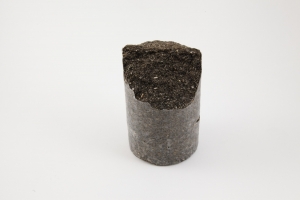
Create a selection
This crumbling, woody cylinder is a biofuel made in the UK from used coffee grounds combined with sawdust, and is a good example of a biomass briquette made from food or agricultural waste. Briquetting is essentially a densification process, whereby a locally abundant but loose and bulky waste material is ground, dried, bound together with a starchy binder made from something like corn, wheat, maize or cassava, and compacted using something like a piston press, hydraulic press or roller press. This process of sequential drying, crushing, mixing with a binder and compacting make for a fuel that is easier to transport, handle and store and that has a high energy value per volume. Examples of other municipal and agricultural organic wastes that are used for briquettes include coconut husks, sawdust, peanut husks, banana peel, rattan waste, sugarcane bagasse, rice husks and paper wastes.
Briquettes are particularly useful in developing country where there’s increasingly limited access to other sources of fuel for cooking and heating water. These briquettes can be used as alternatives to more traditional and less efficient firewood, agricultural residues or kerosene. By comparison to firewood, for example, these compact biofuel briquettes have a higher heat content, good burning efficiency with knock-on effects on improving indoor air quality, and they dispose of local farm and municipal wastes.
Sample ID: 1316
Add materials you find interesting to your own selections.
Use the  button to select a material and get started.
button to select a material and get started.




